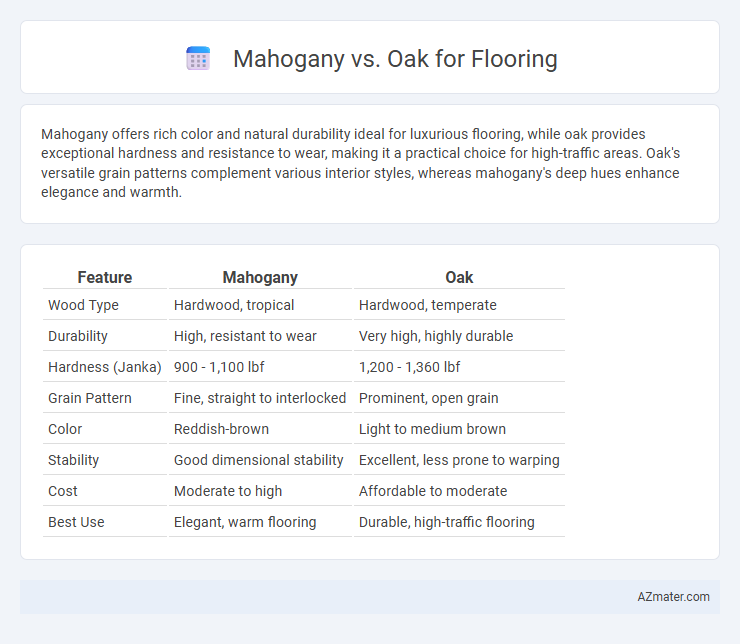Mahogany offers rich color and natural durability ideal for luxurious flooring, while oak provides exceptional hardness and resistance to wear, making it a practical choice for high-traffic areas. Oak's versatile grain patterns complement various interior styles, whereas mahogany's deep hues enhance elegance and warmth.
Table of Comparison
| Feature | Mahogany | Oak |
|---|---|---|
| Wood Type | Hardwood, tropical | Hardwood, temperate |
| Durability | High, resistant to wear | Very high, highly durable |
| Hardness (Janka) | 900 - 1,100 lbf | 1,200 - 1,360 lbf |
| Grain Pattern | Fine, straight to interlocked | Prominent, open grain |
| Color | Reddish-brown | Light to medium brown |
| Stability | Good dimensional stability | Excellent, less prone to warping |
| Cost | Moderate to high | Affordable to moderate |
| Best Use | Elegant, warm flooring | Durable, high-traffic flooring |
Introduction to Mahogany and Oak Flooring
Mahogany flooring offers rich reddish-brown hues and exceptional durability, making it a luxurious choice for high-end interiors with its natural resistance to wear and moisture. Oak flooring, available in red and white varieties, is renowned for its strength, versatility, and attractive grain patterns, providing a classic and timeless look suitable for various design styles. Both woods deliver long-lasting performance, but mahogany tends toward elegance while oak emphasizes robustness and adaptability.
Key Differences Between Mahogany and Oak
Mahogany flooring offers a rich, reddish-brown hue with a fine, straight grain that enhances warmth and luxury, while oak flooring provides greater durability with a prominent grain pattern and natural variations in color, ranging from light tan to deep brown. Oak is harder and more resistant to dents and scratches, making it ideal for high-traffic areas, whereas mahogany is softer and more susceptible to wear but excels in elegance and smooth finishes. Cost-wise, mahogany tends to be more expensive due to its exotic nature and slower growth, while oak remains more affordable and widely available for various interior styles.
Appearance and Color Variations
Mahogany flooring offers rich, reddish-brown hues with deep, warm tones that create a luxurious and classic aesthetic, while oak flooring presents a lighter, more neutral palette ranging from pale beige to medium brown, providing versatile options for various interior styles. Oak wood is characterized by pronounced grain patterns and natural knots, enhancing its rustic charm, whereas mahogany displays a smoother, more uniform texture with subtle grain variations that contribute to its elegant appearance. Both woods develop a beautiful patina over time, but mahogany's darker shades tend to deepen, whereas oak may lighten or darken depending on the finish and exposure to light.
Durability and Hardness Comparison
Mahogany flooring offers a hardness rating of approximately 800-900 on the Janka scale, providing good resistance to dents and scratches, while oak, particularly red oak, typically scores around 1,290, making it significantly harder and more durable under heavy foot traffic. White oak, with a Janka hardness of about 1,360, surpasses both and is often chosen for its exceptional strength and wear resistance. Mahogany's moderate hardness suits moderate-use areas, whereas oak's superior durability ensures longevity and maintains its structural integrity in high-traffic environments.
Maintenance and Care Requirements
Mahogany flooring offers a rich, deep color but requires regular cleaning and periodic refinishing to maintain its luster and resist scratches. Oak flooring is more durable and easier to maintain, with a natural resistance to dents and moisture, making it suitable for high-traffic areas. Both hardwoods benefit from using pH-neutral cleaners, avoiding excessive water, and applying protective finishes to extend their lifespan.
Cost Analysis: Mahogany vs Oak
Mahogany flooring typically costs between $8 and $14 per square foot, reflecting its premium status and rich reddish-brown hue, while oak flooring ranges from $3 to $10 per square foot, making it a more budget-friendly option. Installation costs for both woods vary but generally align with their material prices, with mahogany requiring more precise handling due to its density and grain pattern. Considering long-term durability and resale value, oak offers a cost-effective balance, whereas mahogany may command higher upfront expenses but can enhance property appeal in luxury markets.
Environmental Impact and Sustainability
Mahogany flooring, often sourced from tropical hardwoods, faces sustainability concerns due to deforestation and slower growth rates, impacting carbon sequestration negatively. Oak, predominantly from temperate forests, is generally more sustainable with faster growth cycles and better forest management practices, promoting regrowth and biodiversity. Choosing certified wood products like FSC-certified oak can significantly reduce environmental impact and support sustainable forestry initiatives.
Installation Considerations
Mahogany flooring requires precise acclimation due to its dense wood fibers, which can expand or contract significantly with humidity changes, making moisture control critical during installation. Oak floors are more forgiving with humidity fluctuations and typically allow for easier nailing or stapling, reducing installation complexity. Both woods benefit from a professional subfloor preparation to ensure stability and longevity, but oak's consistency often results in faster installation times compared to mahogany.
Pros and Cons of Mahogany Flooring
Mahogany flooring offers exceptional durability and rich reddish-brown hues that enhance interior elegance, with a Janka hardness rating around 2200, making it harder than many oak varieties. Its natural resistance to decay and insect damage adds longevity to high-traffic areas, though mahogany can be more expensive and harder to source sustainably compared to oak. While mahogany's dark tones may show scratches less visibly, it tends to darken over time, requiring proper UV protection to maintain its original finish.
Pros and Cons of Oak Flooring
Oak flooring offers exceptional durability and resistance to wear, making it ideal for high-traffic areas. Its natural grain pattern and warm tones provide versatile aesthetics that complement both traditional and modern interiors. However, oak can be prone to scratching and may darken over time when exposed to sunlight, requiring regular maintenance to preserve its appearance.

Infographic: Mahogany vs Oak for Flooring
 azmater.com
azmater.com